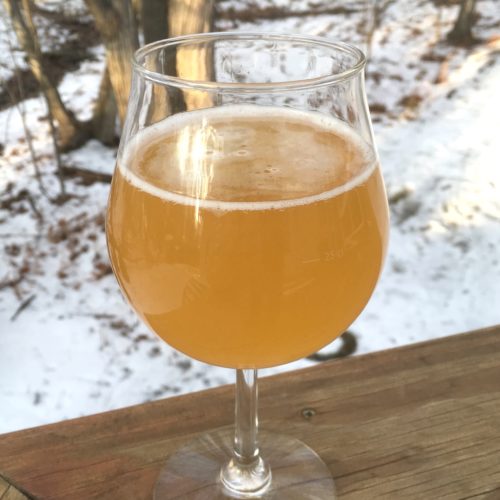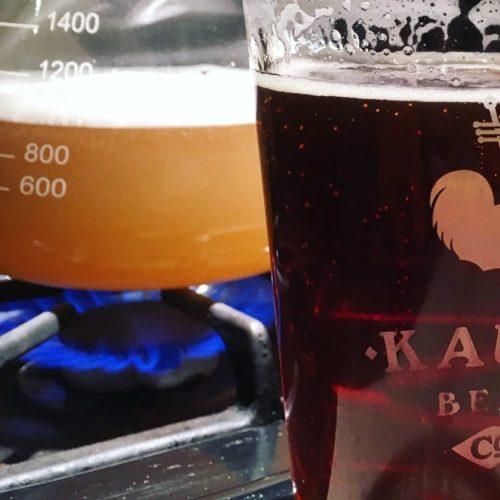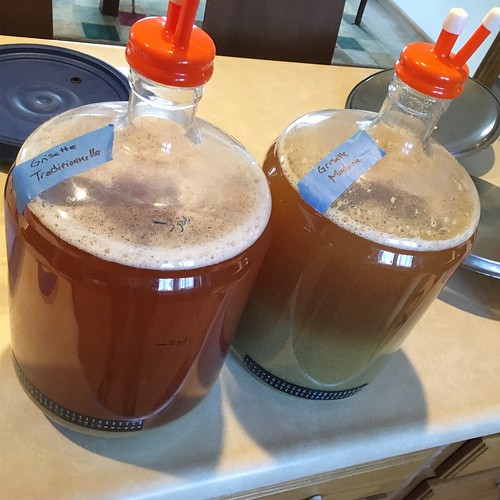Homebrew #48: Grisette Deux Façons
¶ by Rob FrieselAs a variation on a saison, grisette was a style that I instantly fell in love with. Almost immediately afterward I started poking around, plotting how to make one of my own. And after about a year and a half of research and planning, I pulled the trigger on a batch which (for reasons I will explain later) I decided to split. Thus did it become Grisette Deux Façons 1 — with Traditionnelle and Moderne takes.
Ever since my first taste, the saison — that Belgian-heritage farmhouse-style ale — has intrigued me. They are recognizably beer, but they don’t fit comfortably into predictable little boxes. There are so many interpretations of saison — from pale and lightly peppery table beers to dark and truly funky super-strength monsters, and (of course) every variation in between. For me, the main quality that unites the diverse family of farmhouse ales is that they must have some kind of peppery yeast character.
So when I had my first grisette (Oxbow’s Loretta) in June of 2016, it was like a revelation. That spicy-peppery yeast character on full display, tap dancing across that lightly grainy-nutty character imparted from the spelt — and at 4% it was something you could drink all afternoon. I wanted to make one.
But before I could commit myself, I needed first to answer the question: What made a grisette different from a saison?
This proved to be a tricky question to answer. Early research turned up forum discussions on BeerAdvocate and reddit, as well as a number of posts on homebrewing blogs, that did little to clarify the issue. The common themes were (1) a high proportion of wheat and (2) low ABV; otherwise commentary seemed to pull in lots of different directions. Pale vs. amber. French saison yeast vs. mixed fermentation. These sorts of disagreements weren’t surprising but they didn’t help.
I started to notice that many of these discussions referenced Markowski’s 2014 book, so I tracked down a copy of that. Except, Markowski only makes a fleeting reference to the style — which was the same (brief) quote I’d already seen. 2 Ultimately, the style choices I made were influenced by this article in Draft Magazine and Gordon Strong’s style profile that appeared in BYO. 3
At the end of the day, the grisette definition I settled on would go like this:
- table-strength (3-4%)
- high proportion of wheat (20% or more)
- hoppy with a bitter balance and dry finish
- prominent yeast character
- light body but not thin, with high carbonation
In other words: a table-strength saison with a bunch of wheat.
And with that, I worked out a formulation which… sat for a few months. I had every intention of brewing it but 2017 otherwise took on a life of its own.
But then Make the Cut Year 4 was announced and I had a feeling that this was the time to brew this beer.
About That Split Batch
As I started plotting out all the logistics for this beer, I hit a wrinkle in the form of inspiration. I had a Mosaic dry hopped Free Rise from Trillium which set off all kinds of mental alarm bells and conjured up memories of similar beers (looking at you, Surfing Waves of Dopamine, and you E.). It seemed that you could make a farmhouse-style beer that featured modern American and New World hops with all their big audacious aromas and flavors. But… I wanted both!
I puzzled this out and arrived at the only sensible conclusion: split the batch. I went back to the formulation, tweaked it such that I could produce 6 gallons of wort instead of 5, and figured out a low-complexity way to split them on brew day.
Feeling smugly satisfied, I pulled the trigger on this one.
Brew Day
About a day or so ahead of time, I made a starter for the yeast. Nothing extravagant, just 1 liter of wort to give the two packs of 3711 a head start for when they were pitched. (Meanwhile, I enjoyed some Honestatis.)
The night before brewing was to commence, I got my liquor together. Then that morning, bright and early, I put flame to it, mashing in at 151.1°F (which was a degree or two over the target but sure OK let’s run with it…)
While the grist mashed for 90 minutes, I did some additional prep and mise en place. When the mash finished, I pulled the bag, let it drain atop the grill, 4 and did my squeezing. My post-mash/pre-boil gravity was looking like 1.030 — which was about 5 points off where I expected it to be, but still in-band for the style. 5 Given that, I opted to proceed straight to the boil rather than trying to fuss with it.
The boil proceeded. Sterling hops were added. In the meantime, I prepared the gear I would need for after the boil. Which, when the boil completed, I chilled it as quickly as I could down to 140°F. It’s at this point that the split happens…
I opened the valve on the kettle and ran off about 3 gallons of wort into a second kettle, where one ounce each of Mosaic and Galaxy were waiting. That wort was then set aside to steep on those hops for at least fifteen minutes while I chilled the rest of the wort down to 68°F for pitching; once it reached that temperature, I ran it off into a carboy. At this point, and with sufficient time elapsed on the Moderne half, I moved over the wort chiller and finished chilling it to pitching temperatures.
Needless to say, things were a little intense in the kitchen that day.
With both splits in their respective carboys, I took gravity readings. Traditionnelle came up as 1.035; Moderne came up as 1.037. (Seemed fair to record each as unique, but all together it likely would have measured 1.036.)
With the numbers recorded, and the worts at the right temperatures, I pitched approximately 600 mL of 3711 starter into each and put them side-by-side in my fermentation chamber at 72±1°F.
Fermentation
It was bubbling with fair vigor by +5 hours post-pitch, and by +18 things got rather intense in the blow-off bucket.
By +29 things were already starting to slow down, so I bumped the temperature on the controller by a degree. Then again at +48. And again +67. At +91 I took my first gravity reading (1.008 for Traditionnelle, 1.009 for Moderne, added some yeast energizer, and bumped up the temperature again. By +138, I had the temperature up to 80±1°F.
A week after pitching, I’m taking the second gravity reading: 1.005 for Traditionnelle and 1.007 for Moderne. Two days later, gravities are down to 1.004 and 1.007, respectively. Commence dry hopping. (Three days.) Cold crashing. (Two days.) And packaging. (Bottled up the whole batch, primed with corn sugar.)
Then we wait for the bottle conditioning to make with the carbonation.
Overall Impressions
It was truly enlightening to see just how different both of these beers turned out, while still being recognizably of the same lineage. I definitely got what I was going for in both cases, though I’d say that the more traditional preparation was a bigger success than the “modern” take.
(Side note: Moderne isn’t really that much darker; it’s just a trick of the light in the photograph. Oh well.)
Traditionnelle
AROMA. Distinct “saison” character. Strong yeast-derived notes of pepper and spice with background of bubblegum. Malt aromas low/moderate leaning toward light-colored bread or cracker. Hop notes low and a touch spicy, also lightly floral. Peppery notes intensify as it warms. Grainy malt aspect.
APPEARANCE. Pale gold with significant (but not inappropriate) haze. Two fingers of dense foamy white head; persisted about two minutes but left a pleasing ring. Significant fast-rising bubbles.
FLAVOR. Leads with distinct peppery/spicy character. Mid-palate adds light bread character and a moderate grainy aspect. Grainy aspect intensifies toward finish. Hop notes low but supplement with spic and herbal (rosemary? sage?) and floral character. More pepper character and light bubblegum retronasally. Finishes with very dry impression and balance toward bitterness.
MOUTHFEEL. Medium-light body though dry finish suggests it should be lighter. Relatively high carbonation appropriate for style — nice bite. Pleasing.
OVERALL IMPRESSION. Excellent table-strength saison with prominent display of wheat and rye character grains. Expected more yeast expression, though it wasn’t necessarily lacking. While the body was far from dextrinous, I wonder if a change to the mash schedule could boost fermentability and get the finishing gravity even lower and drier.
Moderne
AROMA. Tropical aromas lead: pineapple (moderately high) and mango (moderate) with melon (moderate); those are accompanied by a low citrus (clementine) and apricot. All of that is hop-derived. There is also a moderately strong peppery phenol from the yeast character. Hop- and yeast-derived characteristics are an interesting contrast; they don’t exactly clash but I could see this being a bit much for some noses. Malt aromas largely low to moderate — light bread and cracker, some grainy aspects.
APPEARANCE. Burnished gold color. Substantial haze. Two fingers of dense foamy white head with excellent persistence — at least 1cm still standing after four minutes. Many visible fast rising bubbles.
FLAVOR. Leads with multi-layered fruity/spicy character: strong peppery yeast-derived element over hop-derived notes of medium citrus (tangerine) and apricot followed by moderate pineapple and cantaloupe. Mid-palate, the fruity hop character intensifies. Malt character comes though as cracker and spicy/grainy. Finishes dry with bitter balance. Moderately strong bitterness. Retronasally, tropical fruit is more evident.
MOUTHFEEL. Light side of moderate body. Effervescent carbonation with pleasing bite.
OVERALL IMPRESSION. A table-strength saison treated with a variety of New World hops. (But I knew that already…) Could play well-enough as a session Belgian IPA. Intense aromas are pleasing; peppery yeast character is an interesting contrast. Body seems like it could be lighter. It’s not a hot mess, but there’s a lot going on.
Brief Interlude to Get Feedback
One of these two was going to get entered into Make the Cut. The question before me was… which one? I enjoyed them both but I’m coming at this with strong biases. Which one would be more likely to compete well? I was leaning toward the Moderne take, but… was the just my wishful thinking?
I brought one of each to one of our BJCP study groups and asked my peers there for feedback. That feedback was tremendously helpful. To paraphrase and summarize: “Moderne has a lot going on and we don’t hate it, but it’s like it doesn’t know what it wants to be; Traditionnelle on the other hand is a case study in less-is-more, and it has a very clear story that it wants to tell your palate.”
That was enough for me, and I set aside 6 bottles of Traditionnelle for the up-coming Make the Cut competition drop-offs.
Changes for Next Time?
While I was happy with how both versions from the split batch turned out, there are some tweaks that I’d make going forward.
The Traditionnelle treatment is pretty close to exactly what I wanted. I would consider bumping up the O.G. just a touch — granted that’s also because I was shooting for 1.040 to begin with. I would also look at my mash schedule, and consider a step mash or something else that might help to encourage a more fermentable wort — 1.004 is pretty dry but I wonder if I could get it to 1.002? I’d also consider just slightly more carbonation, but I feel like that might also run the risk of over-carbonating.
As for Moderne — I feel like there has got to be a way to get this into balance. Some of the feedback from my BJCP study group peers was that it might be over-hopped (especially over-dry hopped) given the otherwise low ABV. This one is hard to accept because, especially with the super-fresh bottles, the intense aromas were pleasing and desirable. I would also re-consider exactly which hops go into the whirlpool and/or dry hopping for this one. The interplay of the yeast character and the hop character can work, but maybe it’s just not this specific combination? And of course, I’d like to nail the gravities here as well.
Despite those bits of critique, I am pleased with how this split batch turned out. I’ll definitely be making this again. This will be a nice one to have around in the spring and summer. I think it also might be fun to play around with a fruited version.
(P.S. despite my best hopes, Traditionnelle did not advance to the second round; oh well, next time &c.)
Recipe
The all-grain (BIAB) recipe for Grisette Deux Façons is as follows:
Water Chemistry
Starting with the Champlain Water District profile as a base:
- 0.2 g/gal Gypsum
- 0.2 g/gal Calcium Chloride
- 0.9 mL/gal Lactic Acid (88%)
Summarized on this Bru’n Water spreadsheet.
Mash Grains
- 4 lb. 12 oz. PQM Provenance Pils
- 3 lb. PQM Provenance Wheat
- 2 lb. PQM Rye malt
Hop Schedule
Base beer:
- 1 oz. Sterling (60 min.)
- 1 oz. Sterling (10 min.)
Traditionnelle adds:
1.5 oz. Sterling (dry hop 3 days)
Moderne adds:
- 1 oz. Galaxy (10 min. steep/whirlpool at 140°F)
- 1 oz. Mosaic (10 min. steep/whirlpool at 140°F)
- 1 oz. Galaxy (dry hop 3 days)
- 1 oz. Mosaic (dry hop 3 days)
Yeast
Wyeast 3711 French Saison
Brew Day
- Collect 29.86 qt. water and heat to 155°F. Mash in; hold at 147.9°F for 90 minutes. No mash out.
- Remove filter bag from water. Squeeze filter bag to extract as much liquid as possible for wort. No sparge. Pre-boil volume should be 6.75 gallons.
- Bring to a boil. Boil for 60 minutes; follow hop schedule as described above.
- Cool to 150°F as rapidly as possible. If making a Moderne batch, perform a 10 minute whirlpool/steep with the Galaxy and Mosaic before chilling to fermentation temperatures; otherwise skip the whirlpool/steeping step. Post-boil volume should be approx. 6.25 gallons.
- Aerate wort; pitch 3711 yeast from starter at 67°F.
- Start fermentation at 67°F.
Beyond Brew Day
- Allow fermentation to free-rise up to 72°F; after 3-4 days, increase upper-limit of temperature controller 1°F every 12 hours or so until reaching 80°F.
- Allow fermentation to complete (approx. 2 weeks from pitching).
- If making a Traditionnelle batch, dry hop with Sterling; dry hop Moderne batches with Galaxy and Mosaic.
- Cold crash to separate dry hop matter from beer; do not otherwise fine (some haze is desired).
- Prime with sufficient corn sugar for about 3.0 vols of CO₂ and bottle condition for at least two weeks.
- Enjoy!
Details
Grisette Deux Façons, a versatile Grisette by Tilde Gravitywerks
| Original Gravity | 1.036 |
| Final Gravity | 1.005 |
| ABV | 4.0% |
| Attenuation | 85.7% |
| IBU | 34 |
| SRM | 3 |
| Links | Flickr |
- If you’re curious: yes, my French is 100% Google Translate.[↩]
- This isn’t a dig on Markowski’s book though. I loved that book. It’s had a big influence on my attitudes toward and perspectives on brewing. It just didn’t talk about grisettes to the extent I’d hoped.[↩]
- At the time I’m publishing this blog post, that style profile appears to be behind the site’s paywall. That said, if you’ve got the physical copies lying around, look for the October 2017 issue (Vol. 23, № 6).[↩]
- Which, about that grill… why had I never thought of that before? Really saves the arms to have that in the mix for BIAB.[↩]
- Some back of the envelope post-brew day retro math suggests that the variable here was the local Peterson malts — that maybe they’re not as well-modified as some of the other big players. This isn’t a bad trade, given their rich flavors — just: if I’m going to use their grain, I need to account for the lower diastatic power.[↩]
About Rob Friesel
Software engineer by day. Science fiction writer by night. Weekend homebrewer, beer educator at Black Flannel, and Certified Cicerone. Author of The PhantomJS Cookbook and a short story in Please Do Not Remove. View all posts by Rob Friesel →8 Responses to Homebrew #48: Grisette Deux Façons
Pingback: Homebrew #51: Tilde Porter | found drama
Pingback: 2018 Greg Noonan Memorial Homebrew Competition Results | found drama
Pingback: Homebrew #64: Hoarder Intervention #1 | found drama
Pingback: Homebrew #65: Green Mountain Grisette (Mk. II) | found drama
Pingback: 2018 Brewing Retrospective | found drama









Leave a Reply